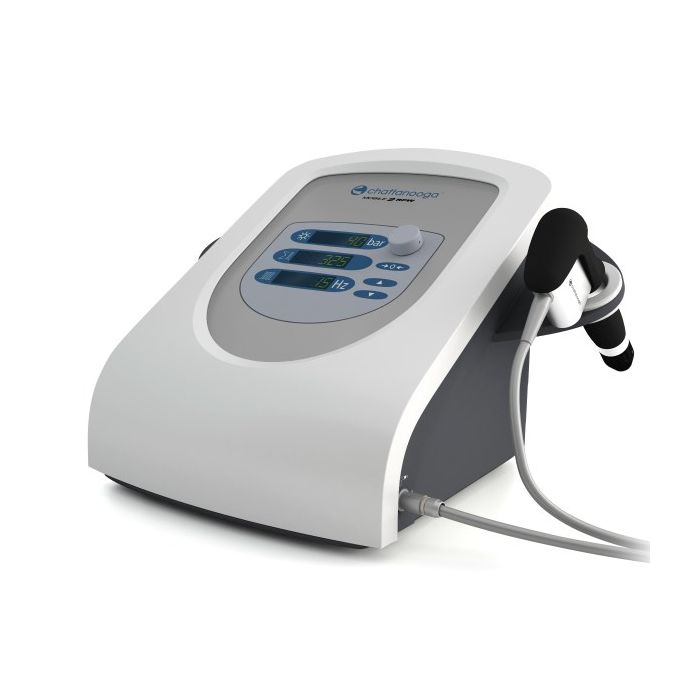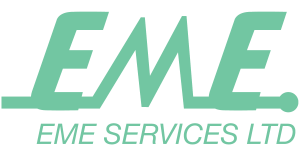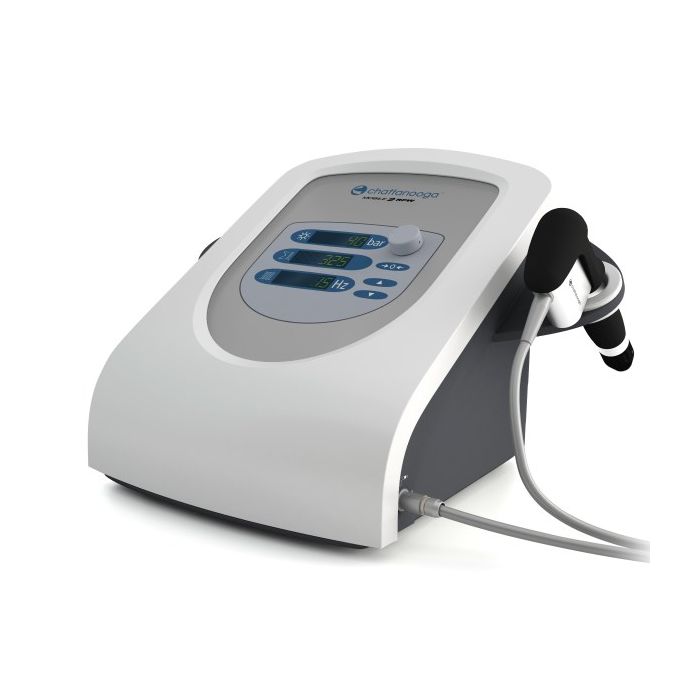Chattanooga
Chattanooga Intelect Mobile 2 RPW Shockwave
Chattanooga Intelect Mobile 2 RPW Shockwave
Couldn't load pickup availability
Mobile Shockwave Therapy Machine
The Chattanooga Intelect Mobile 2 RPW offers radial pressure wave treatment as a non-invasive treatment solution for chronic tendonapathies and other soft tissue disorders.
Treatments administered to the affected areas stimulate the regeneration process of injured tissues which have sustained histological changes.
Radial pressure wave therapy is best indicated for resilent conditions that have not responded to traditional therapy.
Physiological effects of the shockwave include: increased cell permeability, neovascularization, pain control and reduction of adhesions and fibrotic tissue prohibitive of healing.
FEATURES
- Simple, user-friendly navigation
- Transmission gel bottle holder
- Transport handle
- Frequency 1-21Hz
- 1-5 Bars of pressure
- DC quiet compressor
- Universal power supply 110 V-240 V
- 2 year warranty (accessories and hand piece 1 year / 3 million shocks - whichever occurs first)
STANDARD ACCESSORIES
- D-ACTOR Hand piece Applicator
- R15 15mm ESWT Transmitter
- D20-S D-ACTOR 20mm Transmitter
- Conductor Transmission Gel
- Revision Kit
TECHNICAL SPECIFICATIONS
- R-SW Operating Mode: R-SW: single shock, continuous shock 1-21 Hz
- R-SW Energy Selection: Infinitely variable from 1-5 bar
- Mains Frequency: 50/60 Hz
- Mains Fuse: T2AL/250 VAC
- Power Consumption: Max, 150 VA
- Compressed Air Output: 1-5 bar
- Ambient Temperature During Operation: 10-40 °C
- Ambient Temperature Storage & Transport: 5-40 °C
- Ambient Air Pressure: 800-1,060 h Pa
- Classification According to MDD: Class 2A Device
- Progression Against Water: IPX1
EME Services Ltd are authorised service and repair agents for Chattanooga Intelect devices.
RADIAL PRESSURE WAVE THERAPY
Radial shock waves (R-SW) are introduced into the body by means of a freely moved applicator and cover the entire pain region. Radial shock waves are often referred to as radial pressure waves, which is the correct definition in physical terms.
The transmitter is a compressed air operated, ballistic shock wave generator. A projectile is accelerated by compressed air. The kinetic energy stored in the motion and weight of the projectile is converted into acoustic energy in the form of long-wave shock pulses when the projectile strikes a shock transmitter.
Radial shock waves propagate divergently after application and lose energy as the penetration depth increases. They are characterised by long wave lengths and cannot be focused on deep target areas. Penetration depths are between 1 and 3 cm. Their maximum energy flux density is at the exit point from the shock transmitter.
There are different working hypotheses for the mode of action of shock waves which can also be applied to radial shock waves: Shock waves destroy cell membranes. Consequently, the nociceptors are no longer able to produce generator potential and can thus no longer send out any pain signals. Shock waves stimulate nociceptors which, in turn, release a high amount of neural pulses. As described by the Gate Control Theory, transmission of these pulses to the central nervous system is inhibited.
Owing to the mode of action of shock waves, the chemical environment of the cells is changed by free radicals which produce pain inhibiting substances.
Based on the hypothesis towards associative pain memory (Wess), afferent pain signals are transmitted through the central nervous system by multiple synaptic junctions which eventually cause efferent fibers to control muscle tone. The reflex mechanism works just like a regulatory circuit.
During shock wave therapy, strong pain signals are conducted electrically, stimulating chemical processes at the synaptic contact sites. The complex spatial and time-related stimulus pattern is stored at the synapses as a memory engram in the form of longterm modifications. The pathological association between pain and muscle tone and vascular tone is broken as a result of shock wave therapy and the strong stimuli it produces, thus enabling natural movement patterns to be remembered and recalled. In this manner, a non-pathological condition of the muscle tone can be restored.
Treatment results have demonstrated that shock wave therapy provides improved blood circulation in the treated pain regions and that a long term stimulation of metabolism is achieved in areas which, by nature, are poorly supplied with blood. Since repeated treatment sessions have shown to increase the beneficial effects of shock wave therapy, there is every reason to assume that shock waves also produce secondary effects as described in the hypothesis towards associative pain memory, for instance.
RPW SHOCKWAVE THERAPY INDICATIONS
- Localising and Deactivating Trigger Points. Triggers are localised at the low energy level (approximately 2 bar) by passing the transmitter over the muscle region being treated (increased sensitivity to pain) and then deactivated using a higher energy level (approximately 3 bar).
- Increasing Circulation - Promotes blood flow through the tissue and boosting metabolism.
- Pulse Vibration Massage - Soothing relief from muscle strain and stress.
- Plantar Fasciitis, Heel Pain, or Heel Spur - Plantar Fasciitis is an inflammatory condition of the foot caused by excessive wear to the plantar facia that supports the arch.
- Tendinosis Calcarea/Supraspinatus-Tendon - Shoulder calcifications and chronic shoulder pain.
- Radial and Ulnar Humeral Epicondylitis - Tennis elbow, inflammation of tendon attachments on cubital or radial part of elbow joint (humeral).
- Achillodynia - Pain due to inflammation of the Achilles tendon or the bursa associated with it.
- Retropatellar Pain Syndrome - Pain in the front of, behind, and around the kneecap.
- Tibial Edge Syndrome - Pain located along or just behind the medial edge of the tibia.
- Proximal Iliotibial Band Friction Syndrome/Trochanteric Insertion Tendonitis - Pain or aching on the outer side of the knee or hip.
AFTER-SALES SERVICE
EME Services Ltd are authorised, qualified service agents for Chattanooga products. Our experienced engineers fully support Chattanooga devices with annual service, calibration, medical safety testing and repairs.


